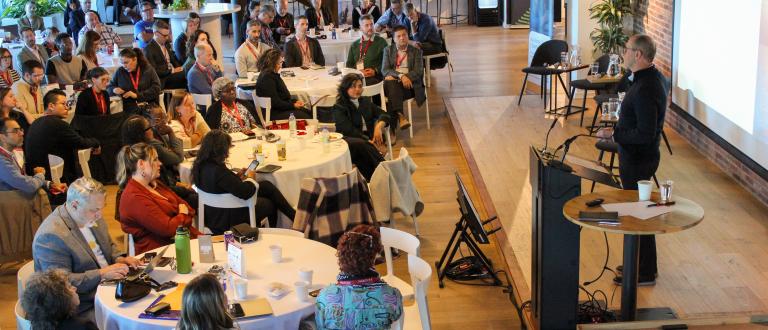There is a widespread perception that nonprofits face a looming leadership crisis. Many senior leaders are expected to retire in coming years, and we are increasingly aware that most organizations do not have a succession plan in place.
However, this is perhaps only the most top of mind talent challenge facing nonprofits. As big a problem as leadership succession, is ensuring that nonprofits can attract and retain young workers in the early stages of their careers.
Anecdotally, we see young nonprofit workers leaving the sector for other opportunities, but we don’t fully understand why. With this in mind, we conducted a series of exploratory interviews with thirteen young nonprofit workers in their early and mid-careers. In these conversations, they offered perspectives on a number of common myths they believe are hurting nonprofits’ ability to attract and retain young staff.
Myth 1: Young people need to pay their dues.
Participants viewed themselves as having paid their dues and then some. Most said their entry into nonprofit work had been through a series of volunteer roles, internships, and short-term contracts, all in the hopes of securing stable employment. They noted that traditional entry-level positions have increasingly been replaced by this type of unpaid and precarious work. The net effect is that nonprofit employers demand far more of young employees, in terms of work experience and commitment to the cause, than ever before.
Opportunity for employers:
When accessing nonprofit employment is this difficult, young people are worn down before they even begin working, and organizations miss out on great candidates that can’t jump over these hurdles. One way nonprofits can offset some of the instability and precarity young workers face is through open communication. Employers can tell staff why their contract is short-term – is it because of the terms of a grant or because the organization faces funding issues? Is the employee being tested before being offered a more permanent role? This kind of clarity helps workers understand the organization’s commitment and allows them to plan for the future. In turn, organizations will benefit from greater employee loyalty and trust.
Myth 2: Young workers have unrealistic salary expectations.
To the contrary, the young workers we interviewed were very mindful of their organization’s financial realities. What they struggled with was the sense that salaries were static and job demands ever increasing. Meanwhile, many are unable to afford reasonable life expenses like child-rearing, home ownership, or saving for retirement, and they see little prospect of being able to do so. In fact, most participants relied on financial support from their family and partners, and said their ability to continue working in nonprofits over the long-term was uncertain. They expressed particular concern about long-term consequences for the sector and society if only young people with privilege can afford to work in nonprofits.
Opportunity for employers:
Acquiring new staff can be costly, with the expenses of hiring, training, and getting staff up to speed all adding up. Organizations can help retain talent by ensuring that employees at all career and life stages can afford reasonable life expenses. Even modest salary increases to reflect growing responsibilities can improve an individual’s finances, and offer a sense that their earning potential isn’t completely static. At a minimum, organizations can communicate with staff about how salaries are decided and the factors that might make salary increases possible. Ideally, when creating new positions, organizations should plan for salary increases that will reflect an employee’s growth with the organization.
Myth 3: Young workers prefer flexible work.
Gotcha - it’s not a myth, it’s actually true. Many participants placed a high value on flexibility – such as the ability to work remotely or work flexible hours. That said, flexibility without proper support from an employer caused stress and disengagement. Flexibility doesn’t replace employment stability, and can actually make an employee feel that an organization isn’t serious about their commitment to them.
Opportunity for employers:
Young workers appreciate flexible working conditions, but not when flexibility feels like ambiguity. When adopting flexible working arrangements, consider the unique challenges they present. For example, some participants noted that flexibility around their work schedule resulted in them working at all hours. Some also noted that working remotely made it difficult for them to collaborate with their colleagues. Additionally, be sensitive to the possibility that permanent and contract workers will experience these challenges differently. Again, communication is key.
Myth 4: Young workers leave the nonprofit sector because other opportunities are more attractive.
There is a widespread perception that when young employees leave, it’s because they’ve been seduced by better opportunities in other sectors. However, participants overwhelmingly described a process of feeling pushed out of the nonprofit sector, rather than being enticed by other opportunities. They cited factors such as inadequate HR management, challenging organizational cultures, lack of clarity around job responsibilities, and limited training and career development as driving a feeling that at some point they would need to seek opportunities in government or business.
Opportunity for employers:
Small improvements, many of which don’t require financial resources, such as open communication and creating a people-focused workplace culture, can improve young workers’ experiences and help them stay in the nonprofit sector. Knowing that young workers feel pushed out of nonprofits rather than seduced by other opportunities strengthens the case for why nonprofits should take incremental steps to improve working conditions. It really isn’t inevitable that young people leave nonprofits for other sectors.
Decent work isn’t a myth.
Improving young nonprofit workers’ experiences is an important way to help the nonprofit sector meet its talent challenges. A key way to accomplish this is by making decent jobs the norm for our sector – jobs where work is stable, fairly compensated, and provides opportunities for growth. Pay equity, while an essential dimension of decent work, is far from the only factor. At the heart of improving young workers’ experiences is a genuine commitment to open communication between employees and the organizations they work for.
To learn more about this subject, download the full research report here.


